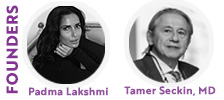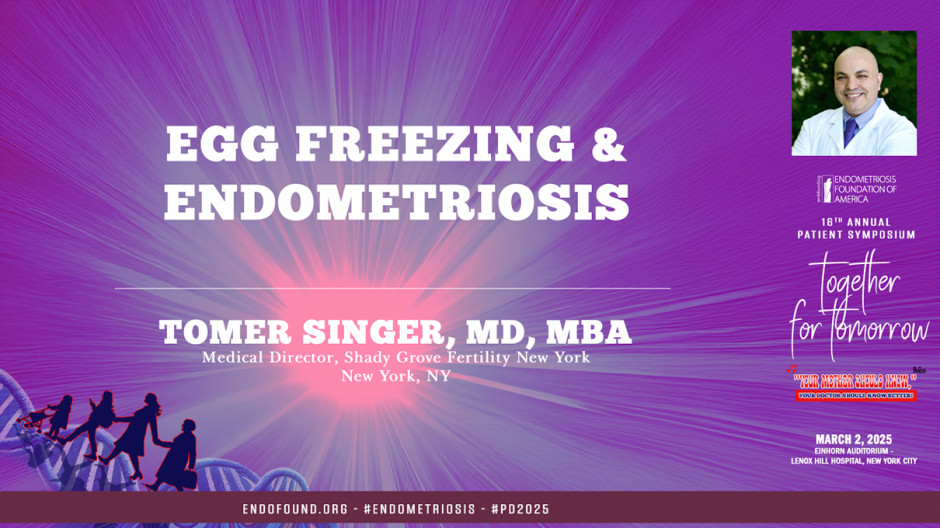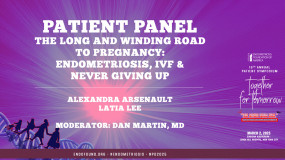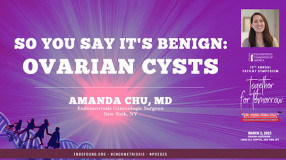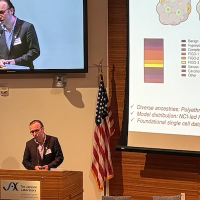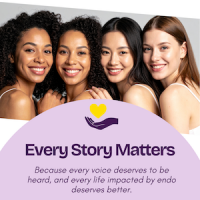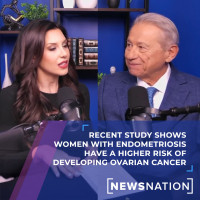16th Annual Patient Day
Your Mother Should Know, Your Doctor Should Know Better!
Patient Day - March 2, 2025
Einhorn Auditorium
Lenox Hill Hospital, New York City
Scientific Director
Dan Martin, MD
Program Director
Tamer Seckin, MD
Hello everybody. All right, welcome back from the break. I'm going to take a second to let everybody get settled. All right. Okay. So I'd like to welcome to the stage our next presenter. He'll be presenting on egg freezing and endometriosis. Dr. Tomer Singer is a distinguished leader in the field of reproductive endocrinology and infertility. As the chief of reproductive endocrinology and infertility at Northwell Health, Dr. Singer has dedicated his career to advancing fertility care and treatment. He is double board certified in obstetrics and gynecology as well as reproductive endocrinology and infertility. He has contributed extensively to the field through numerous publications, chapter views, national international presentations on infertility, IVF, egg freezing and egg donation. With his extensive experience in minimally invasive surgical procedures, procedures including laparoscopies and Hysteroscopies, Dr. Singer brings both expertise and innovation to patient care. So please welcome Dr. Tomer Singer.
Thank you Caroline. And I would like to thank Dr. Kin for inviting me. I think this is the 16 years, so the first time it was here, I just graduated from residency here at Atlantic Seal and went to do my fellowship at Cornell and it's been an honor to come here every year and very proud of Amanda Chu, who was my resident and chief resident, Lenox Hill when I was the vice chairman here and the residency program director. And I really feel that this specific day is very important. The patient awareness day, a lot of things have changed. I think thanks to the Endometriosis Foundation and the awareness can tell you when I became the system chief here at Norwell, the first order of business is to get coverage for endometriosis patients that are employed by Norwell. And Norwell has 86,000 employees. So immediately we increased it to $45,000 coverage plus $30,000 for surrogacy because as you know, a lot of women with endometriosis end up with a hysterectomy at some point and will need that as an option. And also everyone who has endometriosis is now covered for egg freezing. So I hope other institution and other companies will follow. Thank you.
So I have nothing to disclose today. We'll talk a little bit about the scientific background of how endometriosis affect ovarian reserve and equality and then how it really ultimately affects the option of fertility that patient with endometriosis are facing. We'll learn a little bit about ovarian reserve testing and I'm so happy that Amanda started talking about it so we can follow up from her slides and then we'll talk briefly about what it means to do egg freezing when you have endometriosis. So this slide has been presented in the seventies and really hasn't changed much. And what we know is that the best time to get pregnant is right when you're being delivered in the sixth floor here as a female fetus. And jokes aside, at that point you have about 2 million eggs and by the time you get your first menstrual period, what we call the menarchy at age 11 or 12, it already drops to about half a million.
So very depressing. So if you take those 400,000 eggs when you get your first period, and if you think that the patient will have on average menstrual cycles from age 11 to 51, which is the average age of menopause in the us so 40 years, every year you lose about 10,000 eggs. And the other thing that's important to mention is that the eggs are going down in quality. So the 10,000 eggs that you lose when you're in college doing your best not to get pregnant are very different. And when you're in your forties, this slide shows essentially that the best time to get pregnant and also to freeze eggs is in your twenties actually. And in 2012, the American Society of Reproductive Medicine released a notion that egg freezing is no longer experimental. And some of you may remember that after that New York Times started the posting ads and a lot of celebrities started freezing eggs.
And essentially since then we've really seen a boom in egg freezing. So when I was the director of egg freezing here at Atlantic Oak Hill, we used to do one or two a month under IRB, we would speak to the patient, we're not sure if it's going to work. And then this year alone, there's over 50,000 women that are freezing eggs in the United States throughout the nation. So a lot of change in the last decade. What we also know is that when you take those eggs and later on introduce sperm and create embryos, you can now test the embryos and extrapolate from that to learn about the eggs that were frozen at a younger age. And what you can see in this slide is that at age 30, an egg that's going to be fertilized and create an embryo has about 77% chance of being normal.
Whereas if you freeze eggs at age 45, it's not a very fruitful process. So the younger you are, the better chance that that egg that you froze will fertilize, will create a healthy embryo and will achieve a baby. The other thing that we know is that the rate of miscarriages goes up exponentially when you're in your mid to late thirties. So you see the yellow line there, the risk of miscarriage when you're in your twenties is very small, right? 10, 15%. And when you're getting to your forties, over 50% of women who get pregnant, whether it's spontaneously or with IUI or with IVF with untested embryo will have a miscarriage. And that's usually due to chromosomal abnormalities. Trisomy 16, trisomy 13 different situation when an extra chromosome or a missing chromosome have slipped through the crack and essentially created an embryo that would not result in a viable pregnancy.
This slide really is one of the things that we focus on when we speak with patient. We try to get a good family history of medical history, and you can see on the right hand side is endometriosis. And many of the speakers today mentioned how this is the disease that no one knew how to tackle. And thanks to doctors like Dr. Ske and Dr. Chu and many of the audience really people now know to ask the right question, do you have pain during intercourse? How are you menstrual cycles? Do you have an ovarian cyst? Do you have pain in the past when you were a teenager or later on when you completed college? So endometriosis has many, many ways of presenting itself, and if you don't ask the right question, you're going to miss it. It's very simple. And your general OB GN has 10 15 minutes to meet with you and they have to talk about pap smear and HPV and vaccine and safe sex and STD and you have 30, 60 seconds to talk a little bit about sexual life and the pain during a menstrual period.
So a lot of it is educating our general OB GYN to ask the right question and to refer to minimally invasive surgeons, to endometriosis specialists, to psychologists, to reproductive endocrinologists and so forth. So education is really key. So the age is really the most important aspect that affects fertility. And then really endometriosis is one of the things that we see that has an impact on fertility the most. In essence, when you have a fertility patient sitting in front of you, I tell my fellows and my resident, about 30% of them will have endometriosis. It may be silent endometriosis, it may be very early stage because you don't have a large cyst that's telling you the diagnosis when you do the scan, but always suspect endometriosis until proven otherwise. Endometriosis, as I said, up to 30%. Some studies say even 50% of women will have it.
So this is why Tamara and Amanda and I are working very closely because every patient I see most likely has endometriosis and every patient that they see in the reproductive age may want to have kids in the future. So this is where the communication between your surgeon, between your endometriosis specialist, your general OB GN, and the reproductive analysis is helping you plan your future is key here. Some patients have a doctor at Columbia and their OB GN is at Mount Sinai and their surgeon is at NYU. And just to get the three of them to talk to each other can take weeks you've been there. So I think that communication and having the patient be in the center rather than the other Iran and asking the patient to communicate on behalf of the doctor is really where we need to do better. The diagnosis of endometriosis is really often missed by about three or five years.
So if you think about it, if you're in the mid third is complaining of pelvic pain and you have a small cyst and someone is missing it, then you're going to a second OB GYN, and then you ending up with maybe someone who doesn't really know a lot about endometriosis. By the time you get a diagnosis, you could be in your late thirties and as I've showed you in the previous slides, those three or five years are critical. So what are some of the things that endometriosis can cause? It can cause distortion of the anatomy just like Dr. Chu just showed in some of our slides, adhesions in the pelvis scarred fallopian tube. So you may have an even patent fallopian tube. You've a fallopian tube test, and the radiologist said, yeah, I think they're open. But if you think about it, the tubes being open doesn't mean that they're doing their function well.
The way I describe it to my patient is like the partner coming with a scooter from Queens to Manhattan, coming back with a semitrailer. That's the embryo compared to the size of the egg, and that's when you have a risk of ectopic or the embryo not implanting in the right place. So distorted fallopian tube is key. Inflammation, which is everything in endometriosis, the immune system is affected with endometriosis. You all know that some patient benefit from anti-inflammation treatment and nonsteroidal anti-inflammatories, Motrin, ibuprofen, sometimes even steroids. And then the changes their hormonal environment. When you look at the ovarian reserve, we know that when you take a patient with endometriosis and without endometriosis, the A MH is going to be lower, meaning less eggs and the FSH traditionally will be higher, meaning the brain is working harder to convince the ovaries to produce healthy eggs, hence slightly higher risk of miscarriages and much higher risk of infertility.
This is just a diagram that shows you that endometriosis can really affect every pelvic organ. You can see the ovary, you can see the adhesion, the white scar tissue, you can see the fallopian tube, you can see the uterus. Many of our patients also have adenomyosis concomitantly with endometriosis, which causes the uterus to be bulkier, engorged with blood, more pelvic pain. Sometimes the bleeding pattern will be different. So all those are signs and markers for us to suspect that maybe there's something there hidden this couple of intra-op finding. You can see the lesions on the uterus and the ovary on the connection between the fallopian tube and the uterus. And you can just imagine that if an embryo is traveling from the fallopi tube back into the uterus after the sperm fertilize it in the tip of the fallopian tube, that's going to be a challenging road.
This is a patient of mine who you can see had a pelvic ultrasound, had an IUD in place and many of our patients will have an IUD with progesterone secreting to alleviate some of the bleeding issues with some of the pain. And you can see on the right image there is an endometrioma, the black structure there, and you can see that if you're trying to do an egg retrieval on this patient, you will have to go where the red arrow is and go through the uterus sometimes through the I uud, which is challenging into the endometrioma in the search for that one egg that may or may not be fertilized. So very challenging. This is when I'll call Dr. Kin and say, I think I need your help here. Maybe cleared away from me, released the adhesion, maybe even drained endometriomas. So have better access.
So when the patient is doing egg freezing, especially if it's not covered and she'll have to do several cycles, we'll get more eggs than just one or two eggs in each ovary key. You're going through this journey. You want to get the best outcome. You don't want to just put a needle in just because you can On the left hand side, you can see that you a big cyst there. It says endo there and you have the artery. So everything is very narrow. The pelvis is busy, you have a bladder, you have blood vessels, you have ovarian cyst, you have the bowel there. So really seeing an ultrasound, what you're going after is key. This is one of the staging system for our purpose. When you have a minimal or mild endometriosis, the treatment is usually in vitro fertilization when you're trying to get pregnant and you have long lasting infertility over a year, especially if you have blocked fallopian tube.
When the patient has a stage three, stage four, this is when we're going to get the minimal invasive surgery involved and have a plan. Are we doing surgery first? Are we harvesting eggs first and so forth? So let's switch gear to the process of egg freezing. The process itself takes roughly about 12 to 14 days from start to finish. You can see here that the younger you are, the better chances that those eggs are going to yield a good embryo. A good rule of thumb is I would like my patient to have half of their age in eggs. So if a patient is 30, 15, eggs is a good outcome. If a patient is 38, maybe 19 eggs, this rule of thumb doesn't apply when you're in your forties, you'll need many more eggs when you're trying to conceive. It also doesn't really apply to endometriosis, and the main reason is because the uterus is less receptive When you have the eggs and you created an embryo, meaning if I took those eggs and I fertilized them and I created an embryo and I transferred back into the patient with adenomyosis and endometriosis, the embryo has less likelihood of implanting compared to someone without endometriosis who was a surrogate for example.
So you have to compensate for both the endometriosis in terms of the equality and the adenomyosis in terms of the implantation. So it's not just all about the egg. Endometriosis can affect also implantation. This studies or summary from the American Society of Reproductive Medicine essentially showed that there's a very good evidence that when you freeze eggs, you'll get very similar outcome compared to fresh eggs. So when I was sitting with patient before 2012 and they were single, didn't have Mr. Wright or Mr. Mabe, we will talk about, you know what, we can freeze eggs. Let's see how it goes. You're not ready to choose a sperm donor, I understand, but nowadays we know that the outcome is very similar. So we don't have to just choose a donor sperm just in order to freeze the embryos when you're not ready to do so. So that really revolutionized what we do and if we look at the number of IVF or a RT cycles in the United States, this past year it's been 400,000 women who went through IVF and egg freezing, and the biggest portion of women who are actually increasing in terms of number of cycles is the egg freezing.
Young women who are putting essentially matters into their own hands. Some of them have endometriosis, some have fibroids, some have PCOS and some just have not a nice boyfriend who come and freeze eggs in order not to be dependent guys later it really, the egg freezing divides into four steps. So you get the first appointment with your OB GYN, with your reproductive endocrinologist. You do a pelvic ultrasound, you take a very careful history. You look at the ovaries, you ask if there's any signs of symptoms of endometriosis, any history of premature ovarian insufficiency, mom who went into early menopause fibroids, PCOS, you do a pelvic exam and then you run a blood test called an A MH Anti Tamarin hormone and you bring the patient with her period to check a blood test. That's called FSH. That's a blood test that's been used for about 45 years and tells us how hard the brain works to communicate with the ovaries and to release healthy eggs.
The lower the FSH is the better it is. That means the brain is not working too hard. Similar to hyperthyroidism, which some women suffer from Hashimoto's or that the TSH is high, that means the thyroid is not functioning. So what do we do? We give the thyroid hormone in a pill. Unfortunately we don't have eggs in a pill, so what we have to do is to harvest eggs. The other thing that we do is we talk about endometriosis and what can happen when you do egg freezing. A lot of patient want to know the big picture before they freeze eggs. So we'll do an assessment of the opin tube, sometimes send you to Dr. Kin or one of the minimal invasive surgeon to assess the pelvis because we do see a suspicious cyst and eventually you're going to have to use those zis and get pregnant.
So you want to make sure that the pelvis is going to be ready also for implantation. The second stage, second phase is the ovarian stimulation. That's the part that everyone is nervous about. I have endometriosis now I'm going to do two weeks of injection. How would that have an impact? Will it flare up my endometriosis? My estrogen is going to be higher. So sounds counterintuitive, right? So there's always a balance, right? And there's techniques to minimize the risk of endometriosis acting out, you need to keep reminding yourself it's a short-lived process, 10 to 12 days. We have medication that we give as I'm going to show you in a second that keep the estrogen at bay while you're still recruiting follicles and you have very close monitoring. We see you every two or three days early in the morning between six 30 and nine before you go to work.
We check the follicles, we check your estrogen level, we check for the symptoms and we essentially tell you when we think the egg retrieval is going to happen, most women after 12 days of stimulation will be ready. We'll do step three, which is the trigger shot, and in endometriosis will use a medication called Lupron, which some of you probably remember because Lupron is also used in a different dose in a different way to suppress endometriosis. To suppress ovulation. In this specific case we use a Lupron that's a low dose. It's a one shot. It's been given at night, 35 hours before the egg retrieval. And this is how an ovarian stimulation for a patient with endometriosis will look like. We call it the three Ls. Letrozole is a medication that keeps the estrogen low and we do that during the two weeks of stimulation plus few days after the retrieval.
We use low dose. I'd much rather go through a couple of cycles with less eggs rather than have a very high estrogen and have hyperstimulation with a patient with endometriosis that's going to be in more discomfort or pain and lupin as I mentioned for the trigger shot. What you can see here also in yellow that the patient usually will show up with their period on day one or day two. We'll go on birth control pills to leaven the playing field and have everything a little bit more quiescent before we start the stimulation and that way we can recruit more follicles at the same size at the same time. These are some of the medication that we use manpo in the top, which takes five seconds to learn how to do it, to mix it. The foin very similar to all the insulin and ozempic and all the subcutaneous injection that are out there.
And then medication that prevents the patient from releasing the dominant foul coats called G Relic or Cetrotide. And on the right hand side you see HCG, that's the trigger shot in, as I said in endometriosis, will shy away from HCG and use Lupron instead. But that's essentially something that mimics the ovulation that women will see in their middle of the cycle when the brain knows that the egg is ready and will give Lupron to induce that LH hormone. The same hormone that you can buy in CVS pharmacy next to the pregnancy test to see when is the time to have sex or when is the time to avoid sex subcutaneous injection as you can see. And then the egg retrieval. Different centers use different timing, 35 to 36 hours after the trigger. We do it under conscious sedation. The process takes about 15, 20 minutes.
Transvaginal, there's no scar. You put the probe in the vagina, there's a small needle that goes on top. We get eggs from the right, eggs from the left. Patient stays in recovery, get some snacks, pee, walk around and go back to home. Next day patient can go back to work. So it's again under sedation. Usually we give propofol or fentanyl. We have an anesthesiologist who's going to essentially start an IV and you do need to have someone to take you back home that day. Then while we do the egg retrieval, we have embryologists. Those are the special experts who are searching under the microscope, especially in an endometriosis setting to look for those eggs. It's not always as easy to find those eggs when you have an endometrioma, had a patient on Thursday with bilateral endometriosis and you have to search the eggs around the endometrioma and in one of the ovaries I had to go through the endometrioma to get to those four eggs, and that's something that's sometimes a little bit more challenging because the fluid looks a little bit darker, takes a little bit longer to find those eggs. Then the embryologists will take these eggs and usually freeze them in batches of two and it'll have the patient's name, date of birth, the date was frozen, the name of the physician, and I joke that if you have 30 eggs, that's enough for three husbands.
Egg retrieval risks, minimal risk for bleeding, about one in 500. It's done under ultrasound guide. So we know to avoid anything that can cause bleeding infection, especially in endometriosis and especially if you go through the endometriomas, we'll give you doxycycline during the procedure will give IV antibiotics injury to surrounding organs, especially if you had multiple endometriosis surgeries. The anatomy is going to be changing. You need to know what you're looking at, right? Is it the bladder? Is it a vessel? The iliac vessel, which is right next to the ovary. If you don't pay attention, if you don't look at it, it can really look like a follicle. So we use doppler, we use different to make sure that we're in the right angle and right track hyperstimulation is happening in about 2% of women, especially young women, especially women that suffers in addition to endometriosis from PCOS.
So they may get 20 or 30 eggs in one shot. So that's a combination that will be monitoring that patient a little bit more closely. Use low dose of medication and make sure that we monitor post-op more closely. Very rarely you'll have no eggs that are retrieved because we check the estrogen, we check the size of the follicles, we see that they're growing on a regular basis by 1 0 1 and a half millimeter a day, and we know that we give a trigger shot when it's the right time. So all those are very, very rare complications. The technique to freeze the eggs have changed significantly in the last 15 years. In the past, in the eighties, we thought that if we take that egg, which is 90% contains fluid or water, if you slowly freeze it, it's going to protect the membrane. We learned that the other way around.
It's actually true. You want to take that egg and plunge it right away into liquid nitrogen, into minus 320 Fahrenheit and essentially that will have you get about 90 to 95% survival rate when you come back to use those eggs. When we use the slow freezing. In the past only about 10 to 15% of eggs survived. So think about all the women that froze eggs in the nineties and early 2000 when it just the beginning, that's all we had. And they froze 20 eggs and had two or three eggs to work with when they came to use those eggs. So a lot of things have changed and I think that's important to know that when you take the egg and you want to know if the egg is going to be viable, you have to clean the egg from all the cell surrounding it, mainly granulosis of cells.
So what you're actually doing is you cleaning the eggs for two hours after the egg retrieval and that egg is not going to be able to fertilize regularly with sperm. You'll have to pick up the sperm and choose the best one. So you're not going to let the Danny DeVito's log in. You'll choose the schwartzenegger and that's called ii. And then we know that when we take those eggs and we inject the sperm, 60 to 70% of them will fertilize and create embryos, and this is how the development of an embryo in the embryo scope will look like. We watch the embryo grow every two or three hours. There's an internal camera in the embryo scope, so you can have essentially the dividing cells from one cell to two to four to eight all the way to a hundred cells. Pretty amazing. And then another technology that evolved in the past two decades, that was my thesis in fellowship, is to test the embryos for chromosomal abnormalities.
What you do is you remove five cells of what becomes the future placenta, almost like an early amnio if you will, and you can tell the patient, you have a female, you have a male, it's down syndrome, we have to do it again or we have good looking embryos that are also pretested in terms of chromosomes. So that's just a bonus if you're doing egg freezing. This slide shows that if you took those eggs and if you in different age group, the older you are, the more cycles you'll have to undergo in order to get to that normal embryo. You can see that patients who is over 42 years of age, it will have to go to multiple rounds of IVF or egg freezing because only nine to 13% of their eggs are going to be healthy. That's why we recommend doing it when patients are younger than 35 and IVF is usually covered in New York state and it's not something that was true just three years ago thanks to Governor Coleman.
New York became a mandate state, so we can do IVF for embryo freezing if you have a sperm that you're willing to use, but egg freezing unfortunately is not under that mandate. So that's where all of us need to do better and focus on that. You don't need to have a guide in order to freeze your eggs right now. That's the case financially speaking later on when you have that normal embryo. After we created the embryo with injecting the sperm to the eggs, there's a five minute procedure that we transfer the embryo, we bypass the OpID tube, which in many cases is going to be damaged or sometimes even removed in an endometriosis or surgery and 10 days later you'll find that if you're pregnant in terms of outcome, egg freezing is no longer considered experimental. Initially it was used in a lot of patients with cancer and when you call your insurance company they'll say, well, we'll cover egg freezing if it's medically indicated.
Just to learn that medically indicated is a cold word for cancer. That's what we also need to change endometriosis in many cases it's as bad as cancer when you look at the pelvis before and after surgery. So this is the one word I would like to see, the GHI and Cigna and Blue Cross and United and all those insurances, they need to say cancer or endometriosis because that has an impact long lasting impact and some patient would not have kids if they don't have the coverage to do that. The limitation, there's a little bit lower follow-up data when it comes to egg freezing compared to I-V-F-I-V-F has been around for 45 years. I encourage you to watch the Netflix show and the history of IVF. Very nice mini series, but we have now 20 years of data, very reassuring, no increased risk for fetal anomalies.
Very safe. This that one of my partners wrote, and you can see here the number of eggs that the patient has per age. The younger you are, the less eggs you need to get to the best outcome. Affording treatment is key. Really this is what we need to focus on because most patient will have coverage for fertility workup, but many want to have coverage for egg freezing. Usually a cycle can be anywhere between five and $10,000 per cycle plus medication. Just ballpark in summary, egg freezing is a very powerful tool that allows women with endometriosis to freeze their biological clock. It's storing eggs for future age important to educate both OB, GN and the community about the option. There is no guarantee of life birth even if you have 20 eggs because of endometriosis being so tricky and whether to undergo egg freezing in the ideal number to freeze should be personalized based on the patient goals for how many kids, when does she want to have it? And in summary, let's educate our OB, GYN. Tell them to screen for endometriosis, screen for A MH and ask your OB GYN, what should I do? I'm planning to have two kids. I'm 32 with endometriosis. Should I do something about it? Thank you so much.
Caroline, we have three minutes for question or no?
I think we have time for one question.
If it's quick, we can maybe try to do two questions.
Nope, that's a great question. We have embryos that were frozen for 15 years. In fact, there was a case in Colorado that a couple adopted an embryo that was 24 years of age and the patient was 23, so the embryo was older than a mom.
Thank you. I just want to note that, sorry we couldn't get to everyone's questions. There will be a couple more talks on fertility, so hopefully you'll be able to get them answered then. And I think Dr. Singer may be around.

